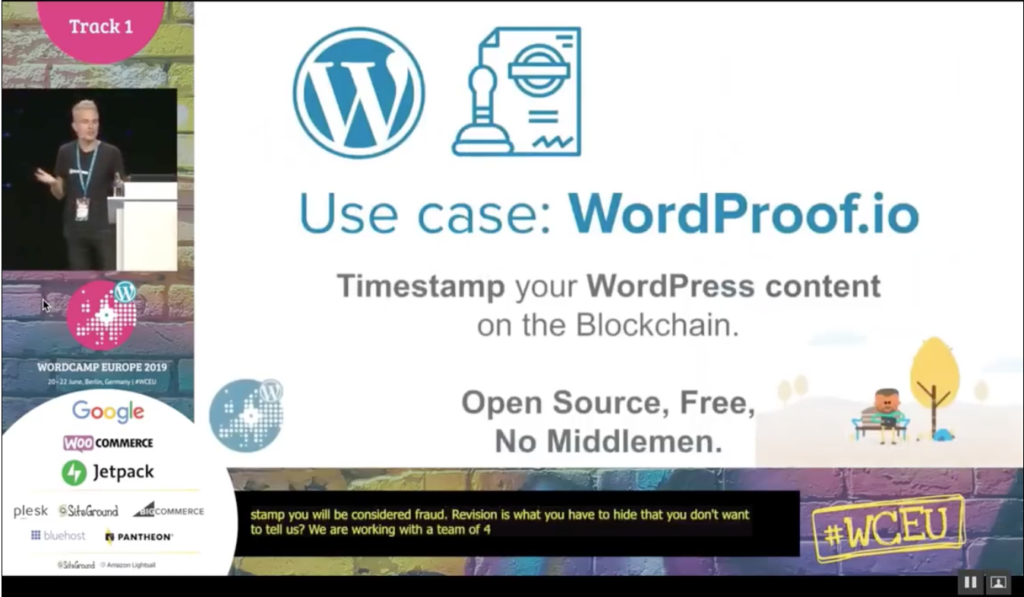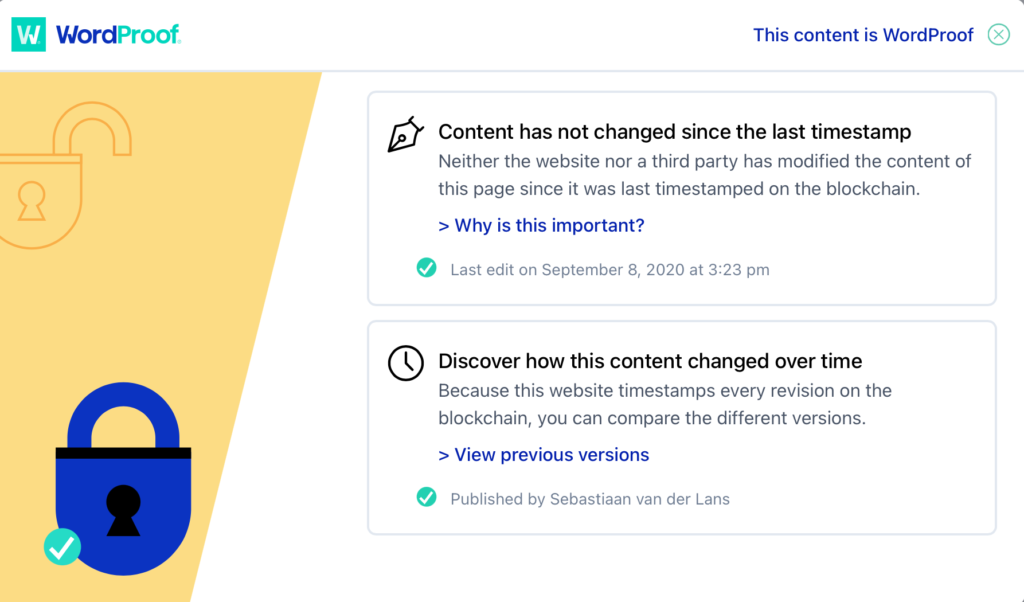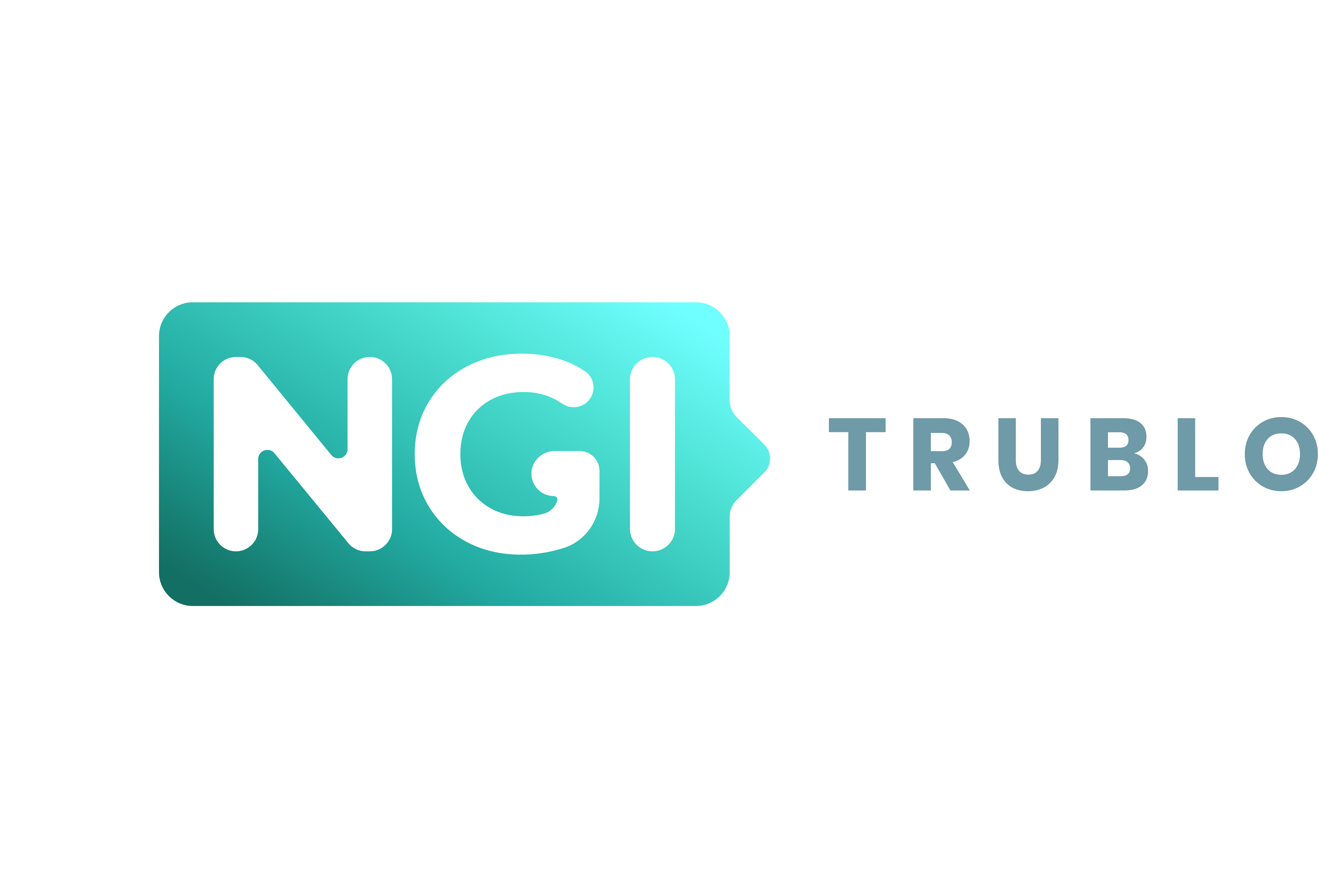Key points:
- WordProof is a start-up enabling easy timestamps for content, then stores that info on a blockchain
- Timestamps are a potential game-changer for verification, ownership of content and search results and on social media
- Integrations are currently available for WordPress, Shopify and via an API
- The start-up from Amsterdam received some financial support from the EU and other sources
Introducing something new
In June 2019 the Dutch developer and entrepreneur Sebastiaan van der Lans entered the stage of WordCamp Europe in Berlin to talk about something new. The title of his talk was: “From WordPress to Blockchain: The future is 100% open source”. Thirty minutes later he received a standing ovation from an audience of roughly 2,500 WordPress developers. Why? Van der Lans took the audience on a journey from the past to the future. He started with the general benefits of the internet for everyone, then moved on to talk about the benefits of open source, where value is created for everyone.

Sebastiaan van der Lans, Founder WordProof.io. Photo: Bob Bronshoff, 2000.
Van der Lans is a strong advocate for open source, because of positive experiences. He is the founder of a web agency and has years of experience. For example, he and his team created a GDPR plug-in, which became very popular. While this project did not generate any direct revenue, the success created tangible benefits for the team and the company.
From publishing to finance to general business the talk advocated a vision of inclusion and fair distribution. WordPress itself is a good example. The software is open-source, it can be self-hosted and used for free. It has become the most popular Content Management System (CMS) worldwide, with a share of 40%, far ahead of commercial platforms. That share of usage has increased in the past years, despite fierce competition in this field.
Blockchain and decentralized communities
But then the presentation took a turn to yet another topic: Sebastiaan talked about blockchain. About decentralized versus centralized organisations. Blockchain is an enabler of new business models and could be a push forward, specifically in the field of content and creative services. A key reason: With blockchain, it is possible to exchange value without middlemen. Only at the very end of the talk, he introduced where opensource, new models and blockchain were all incorporated: The concept of timestamps for content. The presentation received a standing ovation.

A screenshot from the presentation where WordProof was introduced the first time
What is a timestamp?
Essentially, a timestamp is simple. It’s a record of the time and day when a piece of content was published. Based on this information a hash is generated, comparable to a fingerprint. This hash is then stored in a blockchain. As a result, the origin of the content can be verified and that the stated information is correct. It can be trusted because blockchain records are trustable. When the content is changed, the timestamp is updated, creating a transparent record of the content creation process. This way there is a record that can be checked.
It is a simple addition, but there are a number of benefits – for content origin, for ownership and specifically for search:
- Firstly, with a timestamp, a publisher can present proof that the content is original. Everyday content, such as articles, photos, videos is used without permission. So far, there is no real handle to fight this. With timestamps, publishers have a way to legally fight such practices. Securing against unauthorized content use does not have to be all commercial, it can be applied to secure creative commons assets as well.
- Secondly, a timestamp provides a way to determine who published something first. In the news and information business, the time of publication is an important factor. Being first and not just copying content distinguishes one organization from the other.
- Thirdly, with timestamps search could be become considerably better. So far it is relatively easy to trick a search engine. For example, old content can appear as new content if the publishing data is changed. While Google and Co. of course have ways to detect some fraud, it is an ongoing arms race. Determining original quality content is costly. Timestamps could make it much easier to find good information. This could result in a profound change. Once search engines start to consider verified timestamps as a mark of quality, many dynamics of content publishing could change.
Content publishing without timestamps is comparable to cars without registration plates
Why would timestamps be such an important change? For comparison: Just imagine a world where cars were introduced a couple of years ago and are now wildly popular. People enjoy the freedom of being able to go anywhere in a short time. But, in this world, number plates were not invented. When an accident happens, resulting in either a small scratch or injured passengers, it would be almost impossible to identify the cars (and the drivers) involved in the incident. There would be an incentive to hide your identity. There would be no insurance.
What the example shows is this: Sometimes little additions define the characteristics of an entire system. For content, publishing timestamps could be that addition, the missing element which changes many aspects for the better. Since the introduction of the internet, we have witnessed a revolution in how anyone can publish information. We moved from a world where finding certain information would result in spending days or even weeks in a library to getting instant access. Positive again. This is very positive.
But without content data that can be verified, the entire system can be tricked by a few bad actors. Adding verifiable data could change this. Search is a business generating billions of Euros. With timestamps, great content could gain more value in many ways. The good stuff could be displayed on top of searches, there could be models to support authors. This is why timestamps are so interesting. Adding verifiable information in an easy way would help to fight misinformation without making publishing too complex.
How to use the WordProof plugin
Timestamps could be for digital content was number plates are for cars. How difficult is it to install and use this system? First, search for Wordproof in the plug-in section of WordPress. The installation is simple, no blockchain experience needed. One needs to register on WordProof.io for an account. Articles will then automatically get a timestamp. When the content is changed or updated, the timestamp is updated as well. As an option, the timestamp can be displayed along with the content.
Video: Installing WordProof in less than 5 minutes
Steps for the installation
The first step for the installation is to install the WordProof plugin in WordPress. Then the website needs to be registered on WordProof. The set-up is guided and simple, there is no prior knowledge of blockchain needed. Once everything is done all articles will be timestamped and additional information can be displayed under the content. Below is the information which would be shown if the link is opened.

A timestamp of an article, showing information when the content was published.
What does it cost?
To try it out Wordproof.io offers a free tier, which covers 10 timestamps per month. For websites with a more frequent publication, the pricing ranges between 10 and 40 Euro per month. The biggest standard package available covers 1500 timestamps per month on ten different websites and there’s an API available for large users. Some publishers timestamp over 10000 articles a month
The idea of incurring extra costs for authentication and verifications of content will be a barrier forfor adoption. But, as the example with the number plates for cars tried to show: Paying a small amount for trustable content might be a very good investment.
Timestamps to fight misinformation and copyright infringement
Given the problems with misinformation, many media companies should be interested in timestamps. But it might take time towards broad acceptance. Given how easy it is to publish fabricated content there is a latent demand by quality news providers to differentiate reliable information. Search engines need to wake up and start considering timestamps as a mark of quality and a reason to rank such content higher.
Smaller websites should consider using Wordproof, specifically if they publish original content. Paid plans of Wordproof comes with a tool to fight copyright infringements. For larger media companies timestamps are making sense even now. Being able to verify content is a quality in demand. Once search engines start to consider timestamps as an element of ranking, the trend to timestamp content could become the standard, in a relatively short time.
And there is a big driver towards change in the content world. If falsified content is not a motivation, ad fraud should be. Around the world, there is a whole shadow industry aiming to trick search engines and digital ad networks. Ad fraud is estimated at 40 billion US-Dollar per year. In 2023 the amount per year could reach 100 billion.
WordProof as a startup
WordProof has done well working on the idea of timestamps. The company started with small funds in 2019. Then, in June 2020 the team won the amount of one million Euro in a contest of the European Commission. The idea for timestamps came out first in the pan-European competition “Blockchains for social good”. WordProof managed to win in a field of 175 entries.
Dutch news publishers as first customers
The company has won a number of customers. Dutch news publisher NRC for example is using the timestamps for business content. The company uses up to 10.000 timestamps per month, in order to enhance Search Engine results over time. According to WordProof implementation of the system took just four hours. But there are additional use cases, too. Amsterdam Vintage Watches for example uses blockchain and timestamps to ensure the identity, authenticity and ownership of expensive watches.
The Trusted Web Foundation provides background and education
To help with educating users and organizations the team behind WordProof founded The Trusted Web Foundation in 2020. The idea is to have an entity ”that educates, empowers, and accelerates all stakeholders of the internet to land a vision and operationalize timestamping; from consumers to governments, from publishers to policymaker, and from e-commerce platforms to advertisers and media buyers.”
Search engine cooperation announced in 2021
In May 2021 Wordproof.io announced the first partnership with a search engine. A startup called Presearch will incorporate timestamps in search results. Users can easily see the information, even before clicking on content. Presearch is a new and relatively small search offering. But this is a start. The startup currently has 1,5 million registered users. Not many related to the market leader, but more than enough for meaningful tests for timestamps.
Outlook
It will take time for the idea of timestamps to evolve further. But the concept has all the potential to become a mark of quality. In a not too far away future people could see better search results. Once that becomes more common the switch could be fast. Producers of quality content get a number of benefits from this.
It’s a plus that this initiative towards the trusted web is started by a company deeply rooted in the open-source ecosystem. By combining open source and blockchain technologies effective ways to bring back trust to the internet are in the making. It is positive, too, that the approach is supported with European funds.
This article is the first one published by TruBlo using a timestamp. The information is displayed below.
Links:


0 Comments